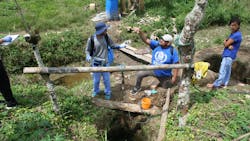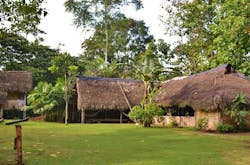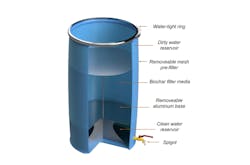University of Kentucky students help Ecuador province obtain clean water
In Ecuador, the Tsáchila people have long endured myriad health problems linked to contaminated water. University of Kentucky Professor Wayne Sanderson and a group of students from the UK College of Agriculture, Food and Environment may have found a likely solution to the dilemma.
Health care providers from UK's Shoulder-to-Shoulder Global program, a medical-aid organization under the university's International Center that aims to improve the health and well-being of underserved communities in Santo Domingo, Ecuador, discovered that residents in the Tsáchila hamlet had a high prevalence of illnesses like gastritis, chronic diarrhea, and anemia — which were traced back to the area’s unclean water. Access to clean water and sanitation are crucial to improving health, including decreasing the child mortality rate and reducing the risk of waterborne diseases.
Most dwellings get their drinking water from shallow wells less than 10 meters deep or from nearby springs and rivers. However, researchers discovered that coliform bacteria contaminated several wells and surface water. To ensure gastrointestinal health, the town needed practical, affordable, and easy-to-maintain clean water infrastructure and sanitation systems.
Researchers found poor water sanitation in 40 of the homes in their study. The unclean water had negative health implications, including chronic anemia in one-third of the children. Because of their complexity and resource shortage, previous water filtration technologies had failed.
The Solution
The locals needed a long-lasting, low-maintenance and affordable filtration option to clean drinking water and promote overall health. The fundamental idea behind the solution was to use agricultural by-products, such as biochar, a black carbon produced from biomass sources such as agriculture waste, to build a single, robust, affordable unit that could supply daily clean water to about eight people.
“The goal of the system that we designed was that the villagers will be able to manufacture and filter the water themselves through their own filtration medium,” said Isaac Hamlin, a 2022 biosystems and agricultural engineering graduate. “This would eliminate the need to purchase a yearly or monthly replacement filter. Instead, the villagers can use the waste material created after harvesting crops. When that is put into a kiln and kept at a specific temperature for a set amount of time, you’re left with the charcoal material, which will become a physical filtration medium.”
The main filter's home is an easily accessible, 30-gallon food-grade polyethylene plastic drum. The drum is fitted with a top opening to directly discharge polluted water from the well. The simple transfer from a shallow well or stream makes beginning the filtration process easier. A detachable base rests against the bottom of the barrel. This holds a tray with holes drilled into it to measure fluid infiltration into a charcoal substance. To ensure even flow across the entire area, a compression plate is attached to a threaded rod and the charcoal filter media is placed on top.
The project’s biggest challenge was designing an affordable system that wouldn’t need any further funding for maintenance. In addition, it had to have a straightforward construction that anyone without technical knowledge could take apart for cleaning and put back together.
“There were some previous attempts in the community to create a filtration system, but they did not take into account the ability of the community to implement and maintain the systems,” said Dylan Buckingham, a 2022 biosystems and agricultural engineering graduate who helped create the filtration design. “Sometimes they would put in a filtration system that no one knew how to maintain or fix just because of a lack of resources available.”
Hamlin will continue to research the filtration system with Sanderson. They hope with more lab research they can determine exactly how much bacteria and other contaminants stay in the water after filtration, guaranteeing water safety.


